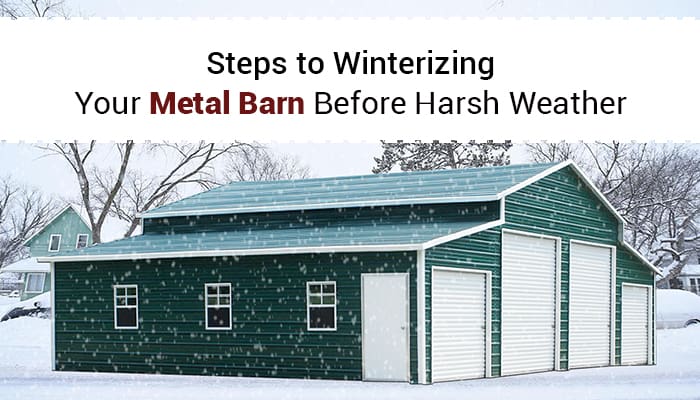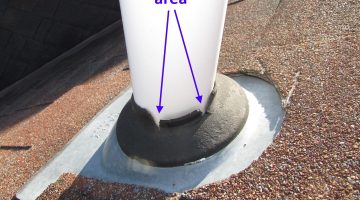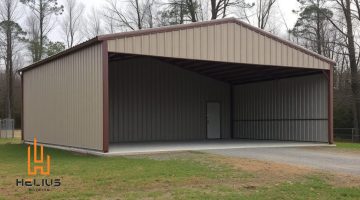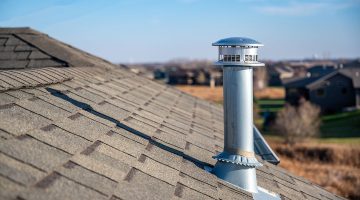By Helius Roofing & Construction

As the cold weather approaches, it’s essential to start thinking about how to protect your metal building from the harsh winter conditions. Whether your metal building is used for storage, as a workshop, or even as a home, proper winterization is key to preserving its longevity and maintaining a comfortable environment during the colder months. Metal buildings are durable and versatile, but they require specific maintenance and preparation to withstand freezing temperatures, snow, ice, and wind. In this guide, we’ll walk you through the steps to winterize your metal building effectively.
1. Inspect and Repair the Roof
The roof of your metal building takes the brunt of winter weather, so it’s important to ensure it is in top condition before the first snowfall. Heavy snow, ice, and freezing rain can put a significant amount of stress on your roof, which could lead to leaks, structural damage, or even collapse if not properly maintained.
Check for Leaks
Start by inspecting the roof for any signs of leaks, rust, or damage. Even small holes or cracks can allow moisture to seep in, which can freeze and expand, leading to more significant damage over time. If you find any leaks, patch them immediately using a high-quality sealant designed for metal roofs.
Clear Debris
Remove any debris, such as leaves, branches, or dirt, from your roof. This debris can trap moisture and cause rusting, as well as block drainage systems. Keeping your roof clean will help prevent water buildup and reduce the risk of ice dams forming along the roof’s edges.
Gutters and Drainage Systems
Ensure that your gutters and downspouts are clear of debris. Clogged gutters can lead to water pooling on the roof, which can freeze and cause damage to both the roof and the gutters themselves. Installing gutter guards can help prevent debris from accumulating throughout the winter months.
2. Seal Windows and Doors
Windows and doors are common areas where drafts can enter, causing heat loss and increased energy bills. Properly sealing these areas is an essential step in winterizing your metal building.
Check for Gaps and Cracks
Inspect the frames around your windows and doors for gaps or cracks where cold air can seep in. Use weatherstripping or caulk to seal any openings. Not only will this help keep your building warmer, but it will also prevent moisture from entering and freezing, which could cause further damage.
Install Insulated Doors and Windows
If your metal building is used as a living space or needs to be kept at a certain temperature, consider upgrading to insulated windows and doors. These will provide better thermal protection and help maintain a consistent indoor temperature during the winter.
3. Insulate Your Metal Building
One of the most effective ways to winterize your metal building is to add insulation. Insulation not only helps keep the interior warm during the winter but also prevents condensation, which can lead to mold and rust.
Types of Insulation
There are several types of insulation suitable for metal buildings:
- Spray Foam Insulation: Spray foam insulation is one of the best options for metal buildings because it forms a seamless barrier that blocks air and moisture. It can be sprayed onto walls, ceilings, and even hard-to-reach areas.
- Fiberglass Insulation: Fiberglass batts or rolls are another popular choice. They are cost-effective and provide good thermal resistance. However, fiberglass insulation must be installed properly to avoid gaps that could allow cold air in.
- Rigid Foam Board Insulation: Rigid foam boards offer excellent thermal protection and can be installed in walls, roofs, and floors. They are particularly effective in preventing heat loss through the roof.
Prevent Condensation
Insulation also helps reduce condensation, which can be a major issue in metal buildings during the winter. When warm air from inside the building meets the cold metal walls, it can cause condensation to form. This moisture can lead to rust, mold growth, and structural damage over time. Proper insulation helps regulate the temperature and prevent condensation buildup.
4. Protect Plumbing and Water Systems
If your metal building has plumbing, it’s critical to protect pipes from freezing during the winter. Frozen pipes can burst, leading to costly repairs and water damage.
Insulate Pipes
Wrap all exposed pipes with foam insulation or heat tape to keep them from freezing. Pay special attention to pipes located in unheated areas of the building, such as crawl spaces or exterior walls. Pipe insulation is a relatively inexpensive step that can save you from significant headaches during the winter.
Drain Water Systems
If your metal building will not be in use during the winter or if certain water systems won’t be needed, it’s a good idea to drain them completely to avoid the risk of freezing. Shut off the water supply and drain any outdoor faucets, hoses, or irrigation systems.
5. Check and Service HVAC Systems
If your metal building relies on heating systems during the winter, now is the time to ensure they are in proper working condition. A well-maintained heating system will not only keep your building warm but also run more efficiently, saving you money on energy costs.
Inspect Heaters
If you use space heaters, furnaces, or radiant heating systems in your metal building, have them inspected by a professional before winter sets in. Make sure they are functioning properly, and replace any filters, belts, or parts that may be worn out.
Consider Adding a Heater
For buildings that will be used throughout the winter, consider installing a permanent heating system if one isn’t already in place. Radiant floor heating or forced-air systems can provide consistent warmth, making your building more comfortable and usable during the cold months.
6. Strengthen Weatherproofing
Winter weather can bring strong winds, snow, and freezing rain, all of which can put stress on your metal building. Strengthening weatherproofing measures can help protect your building from the elements.
Reinforce Fasteners
Over time, the fasteners that hold your metal building together, such as screws, bolts, and clips, can loosen due to wind, temperature fluctuations, and general wear and tear. Inspect these fasteners before winter and tighten or replace any that appear to be loose or damaged.
Weatherproofing Materials
Applying weatherproofing materials like caulk or sealant to joints, seams, and around windows and doors can help prevent cold air, moisture, and snow from entering the building. Make sure to use products that are designed for use on metal and are capable of withstanding freezing temperatures.
7. Prepare for Snow and Ice
In regions that experience heavy snowfall, it’s important to be proactive about snow and ice management for your metal building.
Snow Removal
Accumulated snow on the roof can lead to excessive weight, which could potentially cause damage or even collapse in severe cases. Keep an eye on snow buildup throughout the winter and clear it off the roof when necessary. Use a roof rake or hire professionals for snow removal to avoid damaging the roof.
Prevent Ice Dams
Ice dams can form along the edges of your roof when snow melts and refreezes, preventing proper drainage and leading to leaks. To prevent ice dams, ensure that your roof has proper insulation and ventilation. You can also install heat cables along the roof edges to keep ice from forming.
8. Ensure Proper Ventilation
Good ventilation is essential to maintaining a healthy environment inside your metal building during the winter. Without proper airflow, condensation and moisture buildup can become serious issues, leading to rust, mold, and even structural damage.
Ventilation Systems
Install or maintain roof vents, gable vents, or exhaust fans to allow warm, moist air to escape from the building. Proper ventilation helps regulate the indoor temperature and reduces the risk of condensation on the walls and roof.
9. Inspect the Foundation
The foundation of your metal building can be affected by freezing and thawing cycles during the winter. Inspect the foundation for cracks or signs of damage, and address any issues before the cold weather sets in. Sealing cracks in the foundation can help prevent moisture from seeping in and causing further damage when it freezes.
Conclusion
Winterizing your metal building is a crucial step in ensuring that it remains in excellent condition throughout the colder months. From inspecting the roof to sealing windows and doors, adding insulation, and protecting plumbing, each of these steps helps safeguard your building against the harsh effects of winter weather. By taking the time to prepare now, you can avoid costly repairs, extend the lifespan of your metal building, and create a more comfortable, efficient space during the winter. At Helius Roofing & Construction, we offer a wide range of services to help you winterize your metal building. Contact us today to learn more about how we can assist you in keeping your building in peak condition year-round.









